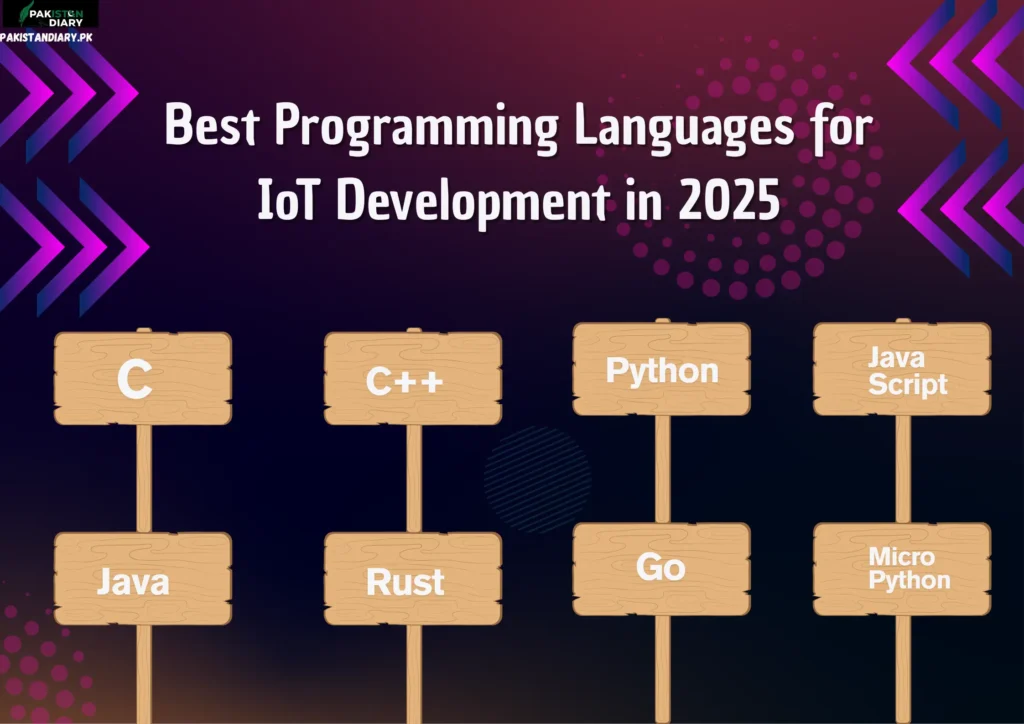In 2025, the Internet of Things (IoT) is expected to grow more and more then ever before. From smart home devices and wearables to industrial machines and healthcare tools, everything is becoming smart and connected. But to make these devices work smoothly, we need the right programming languages.
Choosing the best programming language for IoT is important. Because each device has different needs like memory size, power, speed, or security. Some devices need a lightweight language that runs fast. Others need something simple that beginners can use.
In 2021, when I first began studying about the Internet of Things (IoT) through the use of Arduino and Raspberry Pi, I remember how difficult it was to choose a language. With the help of this blog, beginners, students, and even developers will be able to select the most suitable programming language for the Internet of Things in the year 2025.
Factors to Consider When Choosing a Language for IoT
- Hardware Compatibility: Can the language run on small devices like microcontrollers?
- Memory & Power Efficiency: Does it use less battery and memory?
- Community Support: Is there a big community and lots of tutorials?
- Security & Reliability: Can it keep your IoT system safe?

Best Programming Languages for IoT Development in 2025
C/C++ – Fast and Close to the Hardware
C and C++ are the oldest and most powerful languages in the tech world. These are the languages that run closest to the hardware. That means they control devices at a very low level, making them super fast and efficient.
In my own experience working with Arduino projects, C++ gave me full control of memory and sensors. But it was a bit hard to learn at first.
Pros and Cons:
| Pros | Cons |
| Very fast and powerful | Harder to learn for beginners |
| Great for real-time systems | Manual memory management |
| Works on almost all hardware | Code is harder to write & debug |
Use Cases: Smartwatches, car systems, low-level firmware
Tools Used: Arduino IDE, PlatformIO, Keil uVision
Best Courses:
- “Embedded Systems Programming on ARM” (Coursera)
- “C Programming For Beginners” (Udemy)
Python – Easy and Great for Beginners
Python is one of the most loved programming languages because it’s simple. You can write and understand code quickly. Many people use it for prototyping and data-heavy tasks in IoT like sensors, image detection, and cloud communication.
Pros and Cons:
| Pros | Cons |
| Easy to learn and use | Slower than C/C++ |
| Great for prototyping | Not suitable for low-power chips |
| Huge library and community | Uses more memory |
Use Cases: Raspberry Pi projects, IoT sensors, smart home setups
Tools Used: Raspberry Pi OS, Thonny, Jupyter Notebooks
Best Courses:
- “Python for Everybody” (Coursera)
- “Python Programming for IoT Devices” (EdX)
JavaScript (Node.js) – Best for Web-connected Devices
JavaScript is usually used in websites, but with Node.js, it works well for IoT too. It is useful for real-time apps, dashboards, and web-controlled IoT systems.
Pros and Cons:
| Pros | Cons |
| Perfect for web-connected apps | Not ideal for real-time controls |
| Large community & packages | Higher memory usage |
| Asynchronous, fast for I/O | Slower than C/C++ |
Use Cases: Smart displays, web-controlled IoT devices
Tools Used: Node-RED, Johnny-Five, Raspberry Pi
Best Courses:
- “Internet of Things with Node.js” (Udemy)
- “Node.js Crash Course” (YouTube by Traversy Media)
Java – Stable and Portable
Java is a reliable and secure language, often used in large-scale IoT systems. Its “write once, run anywhere” ability makes it easy to move apps across different devices.
For one of my university projects, we used Java to make a smart irrigation system. The code was easy to transfer from PC to embedded board.
Pros and Cons:
| Pros | Cons |
| Cross-platform support | Slower than native languages |
| Secure and reliable | Needs more memory |
| Good for large IoT systems | Setup can be complex |
Use Cases: Industrial IoT, connected vehicles, large networks
Tools Used: Eclipse, NetBeans, Android Studio
Best Courses:
- “Java Programming for Beginners” (Udemy)
- “IoT Projects with Java” (Pluralsight)
Rust – Safe and Efficient
Rust is a newer language that combines the speed of C++ with better safety. It’s becoming popular for memory-safe and secure IoT projects.
Although I haven’t personally used Rust much, many developers are shifting to it because it avoids bugs and crashes.
Pros and Cons:
| Pros | Cons |
| Memory safe without garbage collector | Steep learning curve |
| Fast and reliable | Smaller community (but growing) |
| Great for secure applications | Less beginner-friendly |
Use Cases: Critical systems, drones, automotive IoT
Tools Used: Cargo, Visual Studio Code, Rust Embedded
Best Courses:
- “Rust Programming Language” (Udemy)
- “Rust for Embedded Systems” (Docs + GitHub examples)
Go – Simple and Scalable
Go (or Golang) is great for cloud-based IoT applications. It’s simple, fast, and designed by Google to handle many tasks at once.
Many programmers use Go for an IoT project that required sending data from multiple devices to the cloud. It handled everything smoothly.
Pros and Cons:
| Pros | Cons |
| Easy to write and read | Not ideal for hardware-level tasks |
| Great for networking and APIs | Limited support on small devices |
| Fast compile time | Smaller ecosystem than Python |
Use Cases: Cloud-based IoT apps, edge computing
Tools Used: GoLand, Visual Studio Code, MQTT libraries
Best Courses:
- “Learn Go for Beginners” (Codecademy)
- “IoT Cloud Apps with Golang” (Pluralsight)
MicroPython – Best for Microcontrollers
MicroPython is a lighter version of Python made for microcontrollers. It lets you use Python on tiny boards like ESP8266 and ESP32.
I used it with ESP32 to control lights via Wi-Fi. It was very easy for someone like me who already knew Python basics.
Pros and Cons:
| Pros | Cons |
| Python-like syntax | Limited libraries |
| Great for beginners | Not as powerful as C/C++ |
| Ideal for small devices | Less support for advanced sensors |
Use Cases: Micro:bit, ESP32, simple sensors and automation
Tools Used: uPyCraft, Thonny, ESPTool
Best Courses:
- “MicroPython with ESP32 and ESP8266” (Random Nerd Tutorials)
- “MicroPython Programming Tutorial” (YouTube & GitHub)

Final Comparison Table
| Language | Speed | Ease of Use | Memory Usage | Hardware Fit | Best For |
| C/C++ | High | Low | Low | Excellent | Real-time, critical apps |
| Python | Medium | High | Medium | Good | Beginners, prototypes |
| JavaScript | Medium | High | Medium | Good | Web-connected devices |
| Java | Medium | Medium | High | Moderate | Large systems, portability |
| Rust | High | Medium | Low | Excellent | Secure, critical systems |
| Go | High | High | Medium | Moderate | Cloud IoT, backend |
| MicroPython | Medium | High | Low | Excellent | Simple IoT boards |
Language Recommendations by Use Case
| Use Case | Recommended Language |
| Home Automation | Python, JavaScript |
| Industrial IoT (IIoT) | C/C++, Java, Rust |
| Health Devices | Rust, Java |
| Agriculture Systems | Python, C/C++ |
| Wearable Tech | C/C++, MicroPython |
Challenges Developers Face in IoT Programming
- Low Memory Devices: Many IoT devices have limited RAM and storage.
- Real-Time Requirements: Some systems must work instantly, like medical alerts.
- Security Issues: Protecting user data is hard when devices connect over the internet.
- Hardware Compatibility: Every board or chip has its own rules.
From my personal experience working on a home automation setup using ESP32, debugging memory overflow in C++ was tough. Later, switching to MicroPython made testing easier but also slower. So, every project needs a balance.
How Beginner’s Get Started with IoT Coding
Basic Tools and Kits:
- Arduino Uno / Nano: Best for learning hardware basics
- ESP32: Wi-Fi enabled, good for real projects
- Raspberry Pi: Mini computer for big projects
Recommended IDEs:
- Arduino IDE (for C/C++)
- Thonny (for Python)
- VS Code (for JavaScript, Go, Rust)
Best Learning Platforms:
- GitHub (open-source code examples)
- YouTube (tons of free tutorials)
- Websites like Arduino.cc, Adafruit, and Raspberry Pi Foundation
Conclusion
There is no single “best” programming language for IoT. It depends on your project, your hardware, and your goals. If you’re just starting, Python or MicroPython is a great choice. If you want more power and speed, go for C/C++ or Rust. For web-based devices, JavaScript is helpful.
Keep learning, keep testing. In the fast-moving world of IoT, the best tool is your curiosity.
FAQs
Q: Which is the best programming language for IoT in 2025?
A: It depends on your project. C++ for speed, Python for ease, Rust for safety.
Q: Is C or Python better for IoT projects?
A: C is better for speed and low memory. Python is easier for beginners.
Q: Can JavaScript be used for hardware programming?
A: Yes, using Node.js and libraries like Johnny-Five.
Q: What languages are used in large IoT systems?
A: Java, C++, and Go are popular in big projects.
Q: Does language choice affect microcontroller performance?
A: Yes! Some languages use more memory or run slower. Pick wisely.





